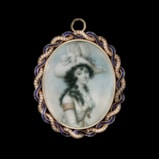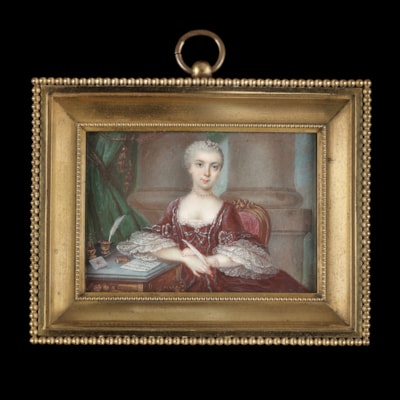RICHARD CROSSE
(1742-1810)Portrait miniature of Miss Turner of Uxbridge, wearing riding costume trimmed with gold braid and a large plumed hat with bows
Circa 1786
Watercolour on ivory
Ivory registration number: 1R4V2ZSQ
Signed and inscribed verso: Richd. Crofse / No 42 / Mifs Turner
Gilt-metal frame enamelled and surrounded with interlocking ribbon detail, alternating with seed pearls
Oval, 63mm (2 ¹/₂ inches) high
SOLD
Throughout the eighteenth century the market and town prospered. Equally important was the coaching trade. At the end of the century up to forty stage coaches a day passed through the town, all stopping to change horses, plus all the private traffic. There were over fifty inns and alehouses to cater for this traffic and four breweries to supply them. The town was so congested that in 1785 the High Street was widened and improved. The Market House was demolished and rebuilt in 1789. Between 1798 and 1805 the Grand Junction Canal was opened, which greatly increased the trade through Uxbridge.
Crosse was born on 24 April 1742 in Knowle, in the parish of Cullompton, Devon; to parents John and Mary Crosse. His father was a lawyer, and his family were members of the landed gentry. Crosse was, like one of his sisters, completely deaf and never able to speak. He had at least six siblings.
Crosse began painting as a hobby, as was the fashion amongst the gentry. At the age of 16 he won a premium at the newly created 'Society for the Encouragement of Arts, Manufactures and Commerce' (the Society of Arts) in London. He then moved to London and, like Richard Cosway and John Smart, he studied at the new drawing school of William Shipley, the founder of the Society of Arts. He also studied at the Duke of Richmond’s Gallery.
Crosse exhibited his work at the new London societies: at the Society of Artists 1760–1796, the Free Society 1761–1766, and the Royal Academy 1770–1796. He lived and worked in Henrietta Street, in Covent Garden, London from 1760. His brother acted as intermediary between Crosse and his clients.
Basil Long in his book "British Miniaturists" (1929) regarded Crosse as a very accurate draughtsman who painted without hesitation or retouching and who will one day receive recognition for his sound, if modest, work.
Despite not being able to hear or speak, Crosse was very successful, and was highly regarded by his distinguished clientele. His clients included the Prince of Wales, and the Dukes of Cumberland and Gloucester. He painted his works mainly with watercolour on ivory; he also executed a few miniatures in enamel, a difficult and not always successful medium; as well as painting portraits in oil.[2]
[1] It is not evident to which version of Miss Turner’s portrait this payment refers, but is most likely to be the large rectangular version of the present work, showing the sitter seated three-quarter length holding a book (see Schidlof, The Miniature in Europe, 1964, vol.III, pl.145, fig.271).
[2] Biography based on information obtained from deafhistory.eu; https://www.deafhistory.eu/index.php/component/zoo/item/richard-crosse?Itemid=155
Important Miniatures from a Private Collection, Sotheby’s, London, 16 April 2008, lot 41 (sold for £10,625);
Private Collection, UK.

shipping notice
Worldwide shipping is included in all prices.
The Limner Company does not accept any responsibility for import duty, this is to be paid by the buyer.
Some stock items contain materials from endangered species which are governed by CITES regulations and will require a permit to export outside of Great Britain. If a certificate of export is required then this will be the responsibility of and paid for by the buyer .
you may also like













